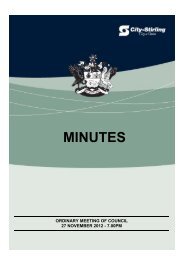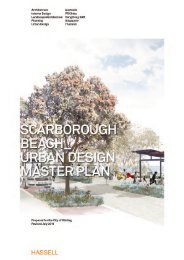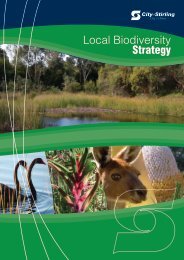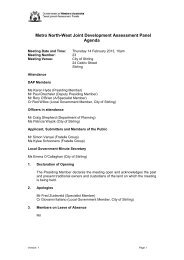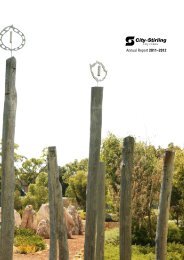Wembley Local Area Plan - City of Stirling
Wembley Local Area Plan - City of Stirling
Wembley Local Area Plan - City of Stirling
You also want an ePaper? Increase the reach of your titles
YUMPU automatically turns print PDFs into web optimized ePapers that Google loves.
economic development<br />
economic development<br />
issues & op portunities<br />
The <strong>Wembley</strong> Downs <strong>Local</strong> <strong>Area</strong> is predominantly<br />
characterised by low density residential<br />
development. There are, however, several<br />
small local centres that service the needs <strong>of</strong><br />
local residents, including Woodlands Village<br />
on Rosewood Avenue, <strong>Wembley</strong> Downs<br />
Shopping Centre and the Flynn Street<br />
shopping area (Herdsman Fresh site).<br />
These local centres serve important<br />
functions in the <strong>Local</strong> <strong>Area</strong>. Such centres<br />
provide convenient retail goods and<br />
services and can serve as important<br />
community hubs. The most common<br />
non-residential use in the <strong>Local</strong> <strong>Area</strong> is<br />
convenience retail and shopping, and there<br />
are few <strong>of</strong>fice precincts within this <strong>Local</strong><br />
<strong>Area</strong>.<br />
Given the <strong>Local</strong> <strong>Area</strong> is on the southern<br />
boundary <strong>of</strong> the <strong>City</strong>, it is expected that the weekly<br />
shopping needs <strong>of</strong> residents are best served outside<br />
the <strong>City</strong>’s boundaries, most likely at Floreat Forum,<br />
which is located within the Town <strong>of</strong> Cambridge to the south <strong>of</strong><br />
the <strong>Local</strong> <strong>Area</strong>. Residents living in Woodlands may utilise the<br />
Innaloo Shopping Centre and the future <strong>Stirling</strong> <strong>City</strong> Centre for<br />
their weekly shopping needs.<br />
Part <strong>of</strong> the <strong>City</strong>’s role is to ensure that the location and function<br />
<strong>of</strong> the commercially zoned land not only works in harmony with<br />
one another but also integrates with the residential community<br />
surrounding it. These local centres can function as a focal<br />
point or meeting place for the community while also meeting<br />
the functionality <strong>of</strong> a localised shopping area, as well as being<br />
employment hubs. Many <strong>of</strong> these centres were first developed<br />
as a ‘corner deli’ and have expanded over time. Such centres<br />
present opportunities to increase the diversity <strong>of</strong> neighbourhoods,<br />
including the opportunity for more people to access such centres<br />
through increased residential densities in and around the<br />
centre.<br />
This <strong>Local</strong> <strong>Area</strong> plan aims to strengthen and consolidate the<br />
already established nodes <strong>of</strong> local centres within the <strong>Local</strong> <strong>Area</strong>,<br />
achieving connectivity and accessibility to these areas by the<br />
local community.<br />
Over 7,000 residents <strong>of</strong> the <strong>Local</strong> <strong>Area</strong> participate in the<br />
workforce, which is over 50 per cent <strong>of</strong> the total population. Of<br />
the workforce, 57 per cent are employed full-time and 38 per<br />
cent are employed part-time. The average income <strong>of</strong> residents<br />
<strong>of</strong> the <strong>Local</strong> <strong>Area</strong> is $744 per week, significantly higher than the<br />
<strong>City</strong> <strong>of</strong> <strong>Stirling</strong> average and the Perth region <strong>of</strong> $516 and $513<br />
respectively.<br />
The four highest employers by industry <strong>of</strong> residents within the<br />
<strong>Local</strong> <strong>Area</strong> include Health Care and Social Assistance (13.5 per<br />
cent), Pr<strong>of</strong>essional Scientific and Technical Services (12 per<br />
cent), Retail (10.9 per cent) and Education and Training (7.9 per<br />
cent). The three dominant occupations within these industries are<br />
Pr<strong>of</strong>essionals (33 per cent), Clerical and Administrative workers<br />
(14 per cent) and Managers (13.9 per cent).<br />
Analysis <strong>of</strong> the qualifications <strong>of</strong> the residents <strong>of</strong> the <strong>Local</strong> <strong>Area</strong><br />
shows that there was a larger proportion <strong>of</strong> people holding formal<br />
qualifications (Bachelor or higher degree, Advanced Diploma or<br />
Diploma, or vocational qualifications) and a smaller proportion <strong>of</strong><br />
people with no qualifications. Over 50 per cent <strong>of</strong> residents held<br />
educational qualifications and 35 per cent <strong>of</strong> residents had no<br />
qualifications. Of those who did have educational qualifications,<br />
31 per cent were Bachelor or Higher degree, 10.4 per cent<br />
were vocational and 9.9 per cent were Advanced Diploma or<br />
Diploma.<br />
OVERVIEW - SUMMARY OF COMMUNITY CONSULTATION<br />
The consultation relating to the economic environment did not<br />
reveal any substantial shifts from the status quo that presents<br />
itself within the <strong>Local</strong> <strong>Area</strong>. The several local centres located<br />
within the <strong>Local</strong> <strong>Area</strong> have already been significantly redeveloped<br />
with limited opportunities for the higher densities surrounding<br />
the centres, as per the principles <strong>of</strong> the State Government’s<br />
Directions 2031. Woodlands Village has been identified as a<br />
centre <strong>of</strong> priority, meaning a 200m development radius is applied<br />
to the centre, thus allowing the <strong>City</strong> to consider a higher density<br />
for those properties located within the catchment area.<br />
With respect to the generation <strong>of</strong> employment opportunities, the<br />
community was supportive <strong>of</strong> encouraging a mix <strong>of</strong> uses within<br />
the existing centres to attract employment for locals, noting<br />
that some key services had moved out <strong>of</strong> the area (such as the<br />
hardware and butcher shops vacating the Woodlands Village<br />
shopping centre). Despite workshop participants wanting to see<br />
a more diverse range <strong>of</strong> retail outlets and greater employment,<br />
about half (52 per cent) <strong>of</strong> survey respondents felt that the<br />
Community Top Priorities<br />
1. Support and maintain local community activity<br />
2.<br />
hubs.<br />
Facilitate diverse business and employment<br />
opportunities.<br />
3. Improve and revitalise local shopping centres and<br />
areas.<br />
opportunities to work within the <strong>Local</strong> <strong>Area</strong> were about right.<br />
When asked whether survey respondents felt there was sufficient<br />
support for business development in the <strong>Local</strong> <strong>Area</strong>, 31 per cent<br />
agreed whilst 48 percent was unsure. The majority <strong>of</strong> respondents<br />
indicating they are unsure demonstrates a lack <strong>of</strong> communication<br />
to the public on the resources available for the establishment <strong>of</strong> a<br />
business within this <strong>Local</strong> <strong>Area</strong>. Whether a local, state or federally<br />
funded program, some coordination is required to ensure both<br />
the message and the resources are provided to the community<br />
to assist this endeavour.<br />
Revitalisation <strong>of</strong> local centres<br />
A point that was echoed within both the consultation workshops<br />
and the survey responses was that <strong>of</strong> concern with the current<br />
state <strong>of</strong> the existing local centres. It was identified there is a<br />
strong need to re-energise the appearance <strong>of</strong> local centres within<br />
the <strong>Local</strong> <strong>Area</strong>.<br />
This is a view supported by the <strong>City</strong> and implemented in part<br />
through the <strong>City</strong>’s <strong>Local</strong> Centres Improvement Program. This<br />
program is <strong>City</strong> wide and commenced in 2000.<br />
The primary objective <strong>of</strong> this program is to nurture local centres<br />
and their capacity to provide accessible local shopping and<br />
services, local employment and a community focus by:<br />
• Improvements to the appearance, streetscape and image <strong>of</strong><br />
centres;<br />
• Improvements to the layout and operation <strong>of</strong> centres;<br />
• Improvements to the accessibility <strong>of</strong> centres;<br />
• Identification and response to key issues facing centres.<br />
The <strong>City</strong> adopts an inclusive process to its urban design studies,<br />
involving both property owners and the local community.<br />
The <strong>City</strong> has identified various local centres across the <strong>City</strong><br />
to participate in this program. The <strong>City</strong> is currently working in<br />
consultation with landowners <strong>of</strong> the Flynn Street shopping<br />
<strong>City</strong> <strong>of</strong> <strong>Stirling</strong><br />
<strong>Wembley</strong> Downs - Herdsman - Churchlands - Woodlands - <strong>Wembley</strong> <strong>Local</strong> <strong>Area</strong> <strong>Plan</strong><br />
March 2013<br />
26 27<br />
<strong>City</strong> <strong>of</strong> <strong>Stirling</strong><br />
<strong>Wembley</strong> Downs - Herdsman - Churchlands - Woodlands - <strong>Wembley</strong> <strong>Local</strong> <strong>Area</strong> <strong>Plan</strong><br />
March 2013




